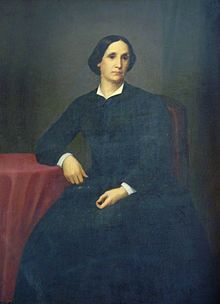Mercedes Jijón
Mercedes Jijón de Vivanco | |
|---|---|
 Mercedes Jijón circa 1840 | |
| First Lady of Ecuador | |
| In office 22 September 1830 – 10 May 1834 | |
| President | Juan José Flores |
| Succeeded by | Baltazara Calderón de Rocafuerte |
| In office 1 February 1839 – 6 March 1845 | |
| Preceded by | Baltazara Calderón de Rocafuerte |
| Succeeded by | María Rosa Icaza |
| Personal details | |
| Born | María de las Mercedes Jijón de Vivanco y Chiriboga 25 March 1811 Otavalo, Real Audiencia of Quito |
| Died | 4 June 1878 (aged 67) Quito, Ecuador |
| Resting place | Cathedral of Quito |
| Nationality | |
| Spouse | Juan José Flores |
María de las Mercedes Jijón de Vivanco y Chiriboga (b. 25 March 1811, Otavalo – d. 4 June 1878, Quito) was the first First Lady of Ecuador, serving in that capacity twice alongside her husband, Juan José Flores.
Life
[edit]Mercedes Jijón was born in Otavalo, Ecuador, then part of the Real Audiencia of Quito, on 25 March 1811 to the landowner and merchant Antonio Jijón Chiriboga and his wife, Mariana Vivanco Calisto.[1][2] Mercedes and her ten older siblings were born into a respected and influential, as well as rich, family.[3] Through her father, Mercedes had noble blood from the County of Jijón, which allowed her to launch litigation to claim the title from her cousin, albeit unsuccessfully.[4]
After the Ecuadorian War of Independence and the annexation of the Real Audiencia of Quito into Gran Colombia, the Venezuelan general Juan José Flores was designated Prefect of the Ecuador Department. To legitimize his administration to the people of Ecuador, Flores decide to marry Mercedes,[3] then only 13 years old.
Flores and Jijón were married in the Cathedral of Quito on 21 October 1824 in a ceremony presided over by Archbishop of Quito Nicolás de Arteta y Calisto, their godfather via José Félix Valdivieso. A number of military and political officials were also in attendance, in addition to Jijón's relatives.[4][5][6][7]
Legacy
[edit]Floreana Island in the Galápagos Archipelago was renamed Mercedes in her honor, although this was later changed to commemorate her husband instead.
See also
[edit]References
[edit]Citations
[edit]- ^ Salvador Lara 1996.
- ^ Revista de Estudios Históricos, 1993, p. 445.
- ^ a b "Abolengo" (in Spanish). La Hora. Retrieved 15 April 2015.
- ^ a b Larrea 1974, p. 16.
- ^ Villalba 1994, pp. 50–55.
- ^ Vásconez Hurtado 1981, p. 135.
- ^ Revista Cultural, 1984, p. 359.
Bibliography
[edit]- Larrea, Carlos Manuel (1974). Antonio Flores Jijón, su vida y sus obras (in Spanish). Corporación de Estudios y Publicaciones.
- Salvador Lara, Jorge (1996). El Palacio de Carondelet (in Spanish). National Historical Academy of Ecuador. ISBN 9789978950746.
- Vásconez Hurtado, Gustavo (1981). El general Juan José Flores, primer Presidente del Ecuador: 1800-1830 (in Spanish). Casa de la Cultura Ecuatoriana.
- Villalba, Jorge (2008). Mercedes Jijón Vivanco: esposa del general Juan José Flores (in Spanish). Pontificia Universidad Católica del Ecuador.
- Villalba, Jorge (1994). El general Juan José Flores: fundador de la república de Ecuador (in Spanish). Centro de Estudios Históricos del Ejército.
- "El general Juan José Flores". Revista Cultura (7). Central Bank of Ecuador. 1984.
- Revista de Estudios Históricos (in Spanish) (37–38). Chilean Institute of Investigative Genealogy. 1993.
{{cite journal}}: Missing or empty|title=(help)
External links
[edit]- Origins and descendants of Mercedes Jijón, from the Ecuadorian genealogical database of Mauricio Alvarado-Dávila


 French
French Deutsch
Deutsch